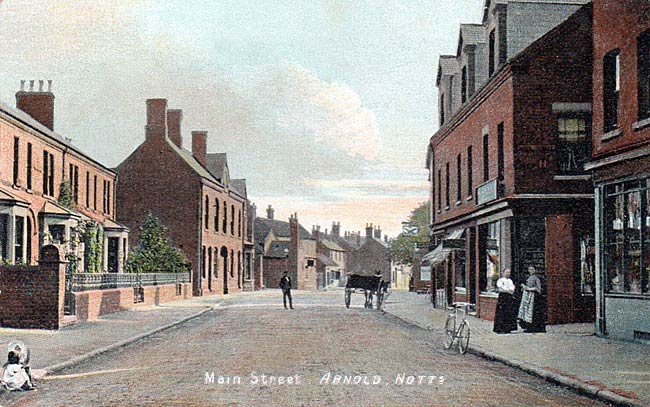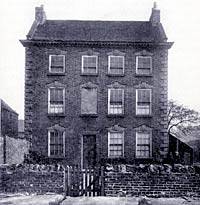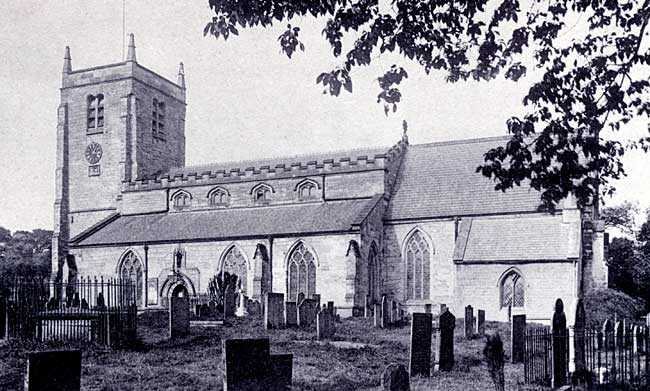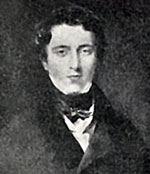Nottingham's Busy Neighbour
ARNOLD. From the earliest days of the stocking frame, invented by William Lee of Calverton near by, this once pretty village of Sherwood Forest has grown into a workaday place. It was one of the places which suffered from the machine-smashing Luddites of last century.

Main Street, Arnold, c.1910.
Nottingham has stretched out an arm to part of it, but we have only to follow the line of hills that shelter it to be soon in the heart of the country, and to find at Dorket Head one of the finest viewpoints of this countryside. Not far away is Cockpit Hill, climbing higher still to 500 feet above the sea, with remains of a Roman encampment. In the bounds of Arnold, at Red Hill, is an old brick farmhouse by the side of the Old North Road where the Mansfield coaches stopped for a change of horses, and here in still earlier days travellers called for guides to take them through the forest. The old stables and their clock are still in the yard, and the lookout balcony is over the porch.

Bonington's house, Arnold, in 1913.
In a big three-storeyed house rising above its neighbours in a quiet street was born Richard Parkes Bonington, whose pictures are among the treasures of our land and won for him imperishable fame as a painter. There is a bronze plaque of him on the house, his statue is in Nottingham, and his pictures are in the Art Gallery at Nottingham Castle and in the Wallace Collection.
Although much restored, Arnold's fine church is a link with faraway days. Part of it was here when Ralph de Arnehall was knighted by Edward the First, and it is said to have been originally built late in the 12th century. The pinnacled tower is 15th century; from the 14th come the nave and the beautiful chancel with its double piscina, blocked sedilia, founder's recess, and battered Easter Sepulchre. Lofty arcades between the nave and aisles are adorned with patriarchical heads.

Arnold church, c.1913.
The graceful chancel screen, with a vaulted canopy and a lovely cornice, the stalls, the reredos, and the marble pavement of the chancel were the gifts of Frank Evelyn Seely'who was lay rector here and died in 1928. The ancient chapel of St Catherine is restored in memory of 250 men who did not come home from the war. One of the men who did come home was William Johnson, who won the VC towards the end of the war, having shown wonderful courage in capturing two machine guns and, although badly wounded, continuing to lead his men forward.
The new porch was built by the widow of Sir John Robinson of Worksop Manor, of whom we read that "he was born beneath the shadow of this church, and throughout his boyhood and youth passed continually through these doors." He was a great public benefactor, building almshouses at Sherwood and Daybrook and endowing a church at Worksop.
An interesting list of Arnold's vicars from 1250 is filled out with history and notes of contemporary events.
The Young Englishman in France

Richard Parkes Bonington (1802-1828).
RICHARD PARKES BONINGTON was one of the painters of genius whom the Midlands added to the great school of English water-colourists of the first part of the 19th century, though his own painting was in oil as much as in water-colour, and the greater part of it was done in France.
There chance directed him. Born in 1802, the son of an Arnold man who was in turn the unsuccessful governor of a gaol, a painter who exhibited at the Royal Academy, and a lace manufacturer, he moved with the family to Calais in connection with the lace business.
But young Bonington, who from his earliest boyhood had shown a talent for drawing and an incurable propensity to improve it on every possible occasion, would have nothing to do with the lace factory, and fortunately gained encouragement and instruction from Louis Francia the water-colourist, and afterwards from the great Delacroix.
Delacroix saw him copying the Flemish landscapes at the Louvre, and a friendship sprang up between the two. Soon young Richard's water-colours commanded a ready sale. He still kept to his own line and though, when he was 21, he exhibited at the Salon and won a prize, he continued to paint in the open air and to disregard academic tradition. In the year when he received a medal for two of his French coast scenes a similar honour was conferred on two other Englishmen, Constable and Copley Fielding, and he stands with them as the founder of the illustrious modern school of French landscape painting which eventually produced Rousseau and Corot.
But if we may say that his influence was great his life was short, for he died only seven years after his first Salon picture. He came to England, once with Delacroix, and exhibited at the Royal Academy, but France saw and collected the greater number of his paintings, which are now much scattered, though there is a noble and representative group of them gathered in the Wallace Collection and others in the Art Gallery at Nottingham Castle.
A Crime of Long Ago
ASKHAM. Orchards abound in this quiet place, which has little to show except a church with grey walls, red roof, and Norman walling in the nave.

Askham church, c.1910.
Its 15th century tower has battlements and eight pinnacles, and a modern porch leads inside, where the great charm lies in eight fine windows which have filled the nave with light as long as the tower has stood. The 13th century chancel has a 14th century east window with beautiful tracery. The old priest's doorway is blocked. The spiral altar rails are 17th century.
On one side of the churchyard are three small almshouses rebuilt last century from a foundation of 1658 by one of the Elwes family who lived here. One of them who went from the village to a place in history was Gervase Helwys, baptised here in 1561, and Lieutenant of the Tower in 1613. He is said to have had something to do with the murder of Sir Thomas Overbury, and though it is hard to say how far he was guilty he was hanged on Tower Hill. His uncle Thomas Helwys formed what is thought to have been the first Baptist church in England.
